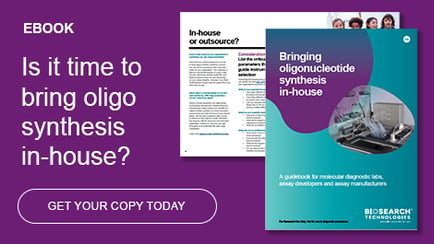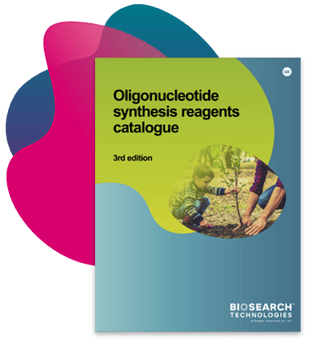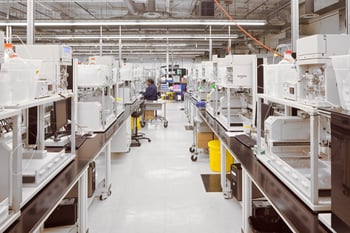Originally published : Mon, December 6, 2021 @ 11:05 PM
Updated : Wed, December 14, 2022 @ 4:45 PM
This is the final blog post in a three-part educational series about best practices for in-house oligonucleotide synthesis.
After synthesising an oligonucleotide via automated phosphoramidite chemistry, it requires post-synthesis processing to become biologically active for end-use applications. There are three main steps involved: cleavage from the solid support, deprotection and purification.
Cleavage and deprotection
After the synthesis cycle is complete, the solid support-bound oligonucleotide is fully protected with:
- a 4,4’-dimethoxytrityl (DMTr) group on the 5'-terminal 5'-hydroxy group
- 2-cyanoethyl groups on the phosphate or phosphorothioate moieties
- acyl protecting groups on the exocyclic amino groups in all nucleic bases (except for T and U).1
To apply the oligonucleotide in downstream applications, it must be cleaved from the solid support and the protecting groups need to be removed. If desired, cleavage and deprotection can proceed simultaneously.
The cleavage step removes the full-length oligonucleotide from the solid support. Cleavage is generally performed using concentrated ammonium hydroxide solution at room temperature. In addition to removing the oligonucleotide from the solid support, this treatment deprotects the sugar-phosphate backbone by eliminating the cyanoethyl group and removing the protecting groups from the heterocyclic bases to yield a single-stranded nucleic acid.2 The final 5’- DMTr protecting group can remain in place to simplify purification, or a final acid treatment can remove it.
Considerations for a deprotection strategy
|
The specific cleavage and deprotection conditions will vary for each oligonucleotide depending on the protecting groups and structural modifications. To determine the most effective deprotection protocol, a thorough review of the oligonucleotide’s components is necessary. Typically, deprotection occurs by heating the solid support in a deprotection solution or gaseous ammonia. Unfortunately, many modifiers and labels used in oligonucleotide synthesis won’t withstand prolonged exposure to the strong alkaline conditions commonly used for deprotection. The UltraMILD monomers – phenoxyacetyl (Pac)-dA, acetyl (Ac)-dC and iso-propylphenoxyacetyl (iPr-Pac)-dG – were developed to allow milder deprotection conditions for the incorporation of sensitive labels and tags into an oligonucleotide. |
For more deprotection strategies, download our Oligonucleotide synthesis reagents product guide. |
These monomers allow deprotection with 0.05 M potassium carbonate in methanol at room temperature. The UltraMILD monomers can also be deprotected using ammonium hydroxide solution. In fact, acetyl is the protecting group of choice for dC because it is compatible with all deprotection conditions.
Here are a few questions to consider when planning a deprotection strategy:
- Are there any modifications that require mild deprotection?
- How soon is the product needed?
- Will the oligonucleotide be purified? If so, how?
The answers to these questions can help determine which deprotection method is most appropriate.
| Key takeaway: An effective deprotection strategy is dependent on the oligonucleotide’s components and the reagents, procedure and temperature used. |
Purification
After deprotection, oligonucleotides are typically desalted or purified by reverse-phase cartridge (RPC), reverse-phase high-performance liquid chromatography (RP HPLC), anion exchange HPLC (AX HPLC) or polyacrylamide gel electrophoresis (PAGE).
Choosing the appropriate purification method will ensure that end-product oligos are suitable for their application. It is critical to find the right balance between purity and yield for each application because as purity increases, yield decreases. Resource availability, time considerations and purity requirements can help determine which purification method is most appropriate for the application.
The following processes are routinely used for oligonucleotide purification.
DesaltingDesalted oligonucleotides are suitable for applications such as microarrays, sequencing or qPCR primers. The oligos are treated to remove small-molecule by-products from the synthesis, cleavage and deprotection steps. Desalting is typically acceptable for oligonucleotides with less than 36 bases. Further processing, such as cartridge or HPLC purification, may be recommended to increase purity for longer sequences or oligonucleotides used in sensitive applications. |
|
Reverse-phase cartridge
For unlabeled oligonucleotides (primers), RPC is an excellent option. It typically provides 70% purity, depending on the oligo’s complexity.3 For this method to be effective, the oligonucleotide’s final base must contain the DMT protecting group (“trityl-on”). The hydrophobically tagged full-length "trityl-on" oligonucleotide can be separated easily from failure sequences that lack trityl groups and do not efficiently bind to the cartridge’s resin hydrophobic matrix.4 The purified oligo is then eluted from the cartridge, and the DMT is removed. RPC purification is suitable to enrich the full-length product for oligos that contain 50 bases or less. For longer oligonucleotides, we recommend HPLC or PAGE purification.
Reverse-phase HPLC
RP HPLC is commonly used to purify oligos that contain dyes, and it can eliminate any fluorescent contamination remaining from probe synthesis. This impurity can elevate the background fluorescence and obscure detection of the signal. RP HPLC is also an ideal option for the large-scale synthesis of oligonucleotides with less than 50 bases. Longer oligonucleotides can be purified using this method, although purity and yield may be negatively affected. RP HPLC typically yields products with a purity of ~80%, depending on the oligo’s complexity. The principle of this purification technique is similar to RPC; however, the resins used allow more sample capacity.
Anion Exchange HPLC
AX HPLC is often used as an alternative to RP HPLC when an oligonucleotide contains significant secondary structures, common in sequences with high GC content. AX HPLC eliminates truncated oligos resulting from poor coupling during synthesis, such as quencher-only failure sequences that can afflict probe manufacture. If it remains, this impurity competes with the probe to find the target sequence and may delay the cycles to a threshold value in a qPCR assay.3 AX HPLC is ideal for purifying smaller oligonucleotide quantities; however, for greatest success, oligonucleotide length should be limited to around 40 bases.
Dual HPLC
Dual HPLC purification is AX HPLC followed by RP HPLC. It is a more rigorous purification method than the others described and typically yields products with ~90% purity, depending on the oligo’s complexity. It is an excellent option for oligos that require a high level of purity, such as those used in qPCR assays for industrial applications or those containing modifications such as fluorescent probes.3
Denaturing PAGE
PAGE purification methods use molecular weight instead of charge to separate impurities from an oligonucleotide. It is ideal to obtain a high percentage of full-length oligonucleotide and purify unmodified sequences greater than 50 bases. While a high purity rate is achieved compared to other purification methods, the final yield of a PAGE-purified oligo will be less than one purified with HPLC methods. PAGE typically achieves a purity of more than 95% full-length sequence, depending on the oligo’s complexity. One limitation is that modified oligos don’t separate as effectively with PAGE as HPLC due to their hydrophobic nature.
Purification and final yield
More rigorous purification methods will consequently reduce the final yield of the end product. Salt-free oligos, therefore, deliver the most yield but are generally the least pure. In contrast, dual HPLC and PAGE methods offer the highest purity but a reduced yield compared to other methods.
| Key takeaway: While there are several acceptable methods for achieving oligonucleotide purity, the appropriate choice will depend on its intended use and structure. |
Post-synthesis processing is a critical step in developing an active oligonucleotide that meets an end application’s purity and yield requirements. Our Technical Support team can assist with selecting the appropriate deprotection and purification methods and recommend suitable products for in-house post-synthesis processing.
 |
If you are thinking about bringing oligo synthesis in-house, there are many considerations to account for beyond instrument selection. But the benefits of synthesising your own oligos are clear. Download this guide that summarises all the practical and technical information in a single place, to ensure that your synthesizers run at full capacity and you maximise your return on investment. |
References
- Gibson, W and Koch C. Biotechnology and Genetic Engineering. Ed-Tech Press. Published 2019.
- Ellington, A and Pollard, JD Jr. Introduction to the synthesis and purification of oligonucleotides. Current Protocols in Nucleic Acid Chemistry. A.3C.1-A.3C.22. John Wiley & Sons Inc. Published 2000. https://deepblue.lib.umich.edu/bitstream/handle/2027.42/143751/cpnca03c.pdf?sequence=1
- Oligo purification. LGC Biosearch Technologies. Accessed August 17, 2021. https://www.biosearchtech.com/support/resources/oligo-purification
- Pollard, J.Synthesis of Oligonucleotides. Department of Molecular Biology - Massachusetts General Hospital and Harvard Medical School protocols. Published 1998. Accessed August 20, 2021. https://molbio.mgh.harvard.edu/szostakweb/protocols/oligo/index.htm




